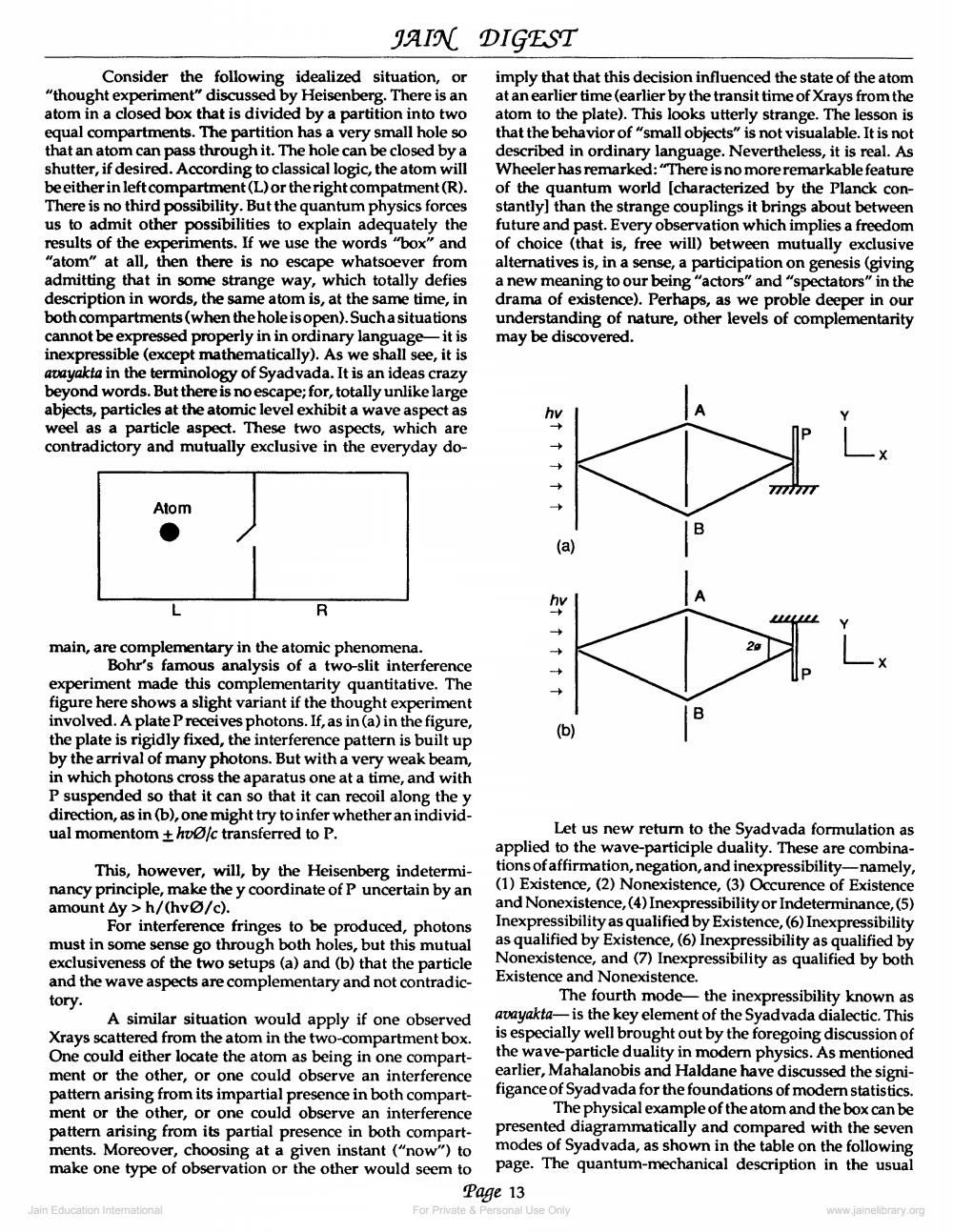________________
JAIN DIGEST
Consider the following idealized situation, or "thought experiment" discussed by Heisenberg. There is an atom in a closed box that is divided by a partition into two equal compartments. The partition has a very small hole so that an atom can pass through it. The hole can be closed by a shutter, if desired. According to classical logic, the atom will be either in left compartment(L) or the right compatment (R). There is no third possibility. But the quantum physics forces us to admit other possibilities to explain adequately the results of the experiments. If we use the words "box" and "atom" at all, then there is no escape whatsoever from admitting that in some strange way, which totally defies description in words, the same atom is, at the same time, in both compartments (when the hole is open). Such a situations cannot be expressed properly in in ordinary language- it is inexpressible (except mathematically). As we shall see, it is avayakta in the terminology of Syadvada. It is an ideas crazy beyond words. But there is no escape; for, totally unlike large abjects, particles at the atomic level exhibit a wave aspect as weel as a particle aspect. These two aspects, which are contradictory and mutually exclusive in the everyday do
imply that that this decision influenced the state of the atom at an earlier time (earlier by the transit time of Xrays from the atom to the plate). This looks utterly strange. The lesson is that the behavior of "small objects" is not visualable. It is not described in ordinary language. Nevertheless, it is real. As Wheeler has remarked: "There is no more remarkable feature of the quantum world (characterized by the Planck constantly) than the strange couplings it brings about between future and past. Every observation which implies a freedom of choice (that is, free will) between mutually exclusive alternatives is, in a sense, a participation on genesis (giving a new meaning to our being "actors" and "spectators" in the drama of existence). Perhaps, as we proble deeper in our understanding of nature, other levels of complementarity may be discovered.
MINT
Atom
R
uu
main, are complementary in the atomic phenomena.
Bohr's famous analysis of a two-slit interference experiment made this complementarity quantitative. The figure here shows a slight variant if the thought experiment involved. A plate Preceives photons. If, as in (a) in the figure, the plate is rigidly fixed, the interference pattern is built up by the arrival of many photons. But with a very weak beam, in which photons cross the aparatus one at a time, and with P suspended so that it can so that it can recoil along the y direction, as in (b), one might try to infer whether an individual momentom + huØlc transferred to P.
Let us new return to the Syadvada formulation as
applied to the wave-participle duality. These are combinaThis, however, will, by the Heisenberg indetermi
tions of affirmation, negation, and inexpressibility-namely, nancy principle, make the y coordinate of P uncertain by an
(1) Existence, (2) Nonexistence, (3) Occurence of Existence amount Ay > h/(hv /c).
and Nonexistence, (4) Inexpressibility or Indeterminance,(5) For interference fringes to be produced, photons
Inexpressibility as qualified by Existence, (6) Inexpressibility must in some sense go through both holes, but this mutual
as qualified by Existence, (6) Inexpressibility as qualified by exclusiveness of the two setups (a) and (b) that the particle
Nonexistence, and (7) Inexpressibility as qualified by both and the wave aspects are complementary and not contradic
Existence and Nonexistence. tory.
The fourth mode the inexpressibility known as A similar situation would apply if one observed
avayakta-is the key element of the Syadvada dialectic. This Xrays scattered from the atom in the two-compartment box.
is especially well brought out by the foregoing discussion of One could either locate the atom as being in one compart
the wave particle duality in modern physics. As mentioned ment or the other, or one could observe an interference
earlier, Mahalanobis and Haldane have discussed the signipattern arising from its impartial presence in both compart
figance of Syadvada for the foundations of modern statistics. ment or the other, or one could observe an interference
The physical example of the atom and the box can be pattern arising from its partial presence in both compart
presented diagrammatically and compared with the seven ments. Moreover, choosing at a given instant ("now") to
a given instant ("now") to modes of Syadvada, as shown in the table on the following make one type of observation or the other would seem to page. The quantum-mechanical description in the usual
Page 13 Jain Education Intemational For Private & Personal Use Only
www.jainelibrary.org




